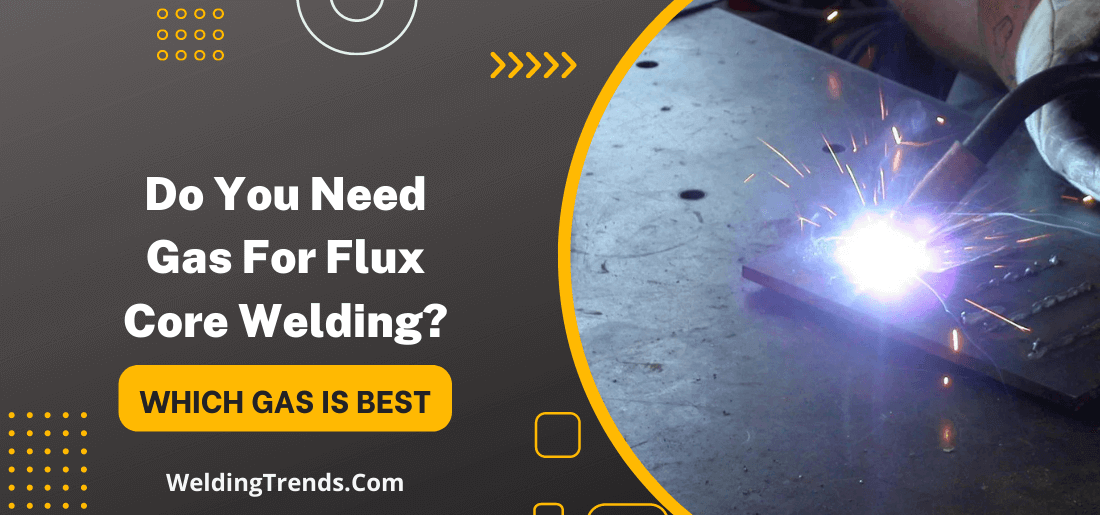Gas is not always necessary for flux core welding. Gasless flux core welding is a process that uses an arc welder to create a weld between two pieces of metal. The welder uses an electrode to create the weld and no gas is needed. This process can be used for many types of metals, including steel, aluminum and brass.
While gasless flux core welding does not produce the strongest welds, it is a great option for beginners or those who are looking for a quick and easy way to weld.
In this post, we’ll take a closer look at how flux core welding works without gas and discuss some of its benefits. We’ll also provide tips on how to get started with this welding process.
How does gas work in flux core welding?
When using flux core welding, an electrode is used that is made up of a metal wire that is coiled around a flux-filled center. This type of electrode can be used with either AC or DC power sources.
The wire is fed through the welding machine and out the tip of the gun where it melts and becomes part of the weld pool. The flux helps to shield the weld area from contaminants in the air and also provides a slag layer that protects the weld as it cools.
Gas is not required when using flux core welding, but many welders choose to use it anyway to get better results. When gas is used, it helps to shield the weld area from oxygen and other contaminants in the air. This creates a cleaner weld and can help to prevent corrosion.
However, there are benefits to using gas when flux core welding than gasless flux core welding which include:
1) More stable arc: Gas welding provides a more stable arc which can help to produce a higher quality weld than without using gas.
2) Cleaner weld: Using gas can help to create a cleaner weld because it helps to shield the weld area from oxygen and other contaminants in the air. This can help to prevent corrosion.
3) Easier to use: Gas welding is often seen as being easier to use than flux core welding, especially for beginners. This is because the gas helps to shield the weld area and makes it easier to produce a consistent weld.
4) Fewer weld defects: When using gas welding, there are often fewer weld defects due to the fact that the weld area is shielded from oxygen and other contaminants. This can help to produce a higher quality weld
5) Less spatter: Gas welding often produces less spatter than flux core welding. This is because the gas helps to shield the weld area and prevents oxygen from getting into the weld pool.
6) Better penetration: Gas welding can often provide better penetration than flux core welding. This is because the gas helps to shield the weld area and prevents oxygen from getting into the weld pool.
7) Higher quality welds: Overall, gas welding can produce higher quality welds than flux core welding. This is because the gas helps to shield the weld area and prevents oxygen from getting into the weld pool.
Additionally, using gas can help to create a cleaner weld and can often help to prevent corrosion.
What type of gas should you use for flux core welding and where can you buy it from?
When using flux core welding, the most common gas to use is 100% Argon. This is because it provides the best shielding properties. However, if you are welding outdoors, you may need to use a different gas mixture to protect the weld from the wind.
You can buy Argon gas from most welding supply stores or online retailers. It is important to make sure that you get the right type of gas for your welding machine and that you follow all safety instructions when using it.
Are there any dangers associated with using gas with flux core welding and how can you avoid them?
There are a few dangers associated with using gas with flux core welding, but they can be easily avoided if you take the proper precautions.
- The most common danger is that the gas can leak and cause an explosion. To avoid this, always make sure that your welding machine is properly ventilated and that you have the right type of gas for your machine.
- Additionally, always follow the safety instructions that come with your welding machine.
- Another danger is that gas can build up in the welding area and cause asphyxiation. To avoid this, always make sure that you have ventilation when using gas with flux core welding.
- Never weld in an enclosed space without ventilation.
- Finally, always make sure that you turn off the gas before you disconnect your welding machine. This will help to prevent any accidents.
FAQs – gas for flux core welding
Do you need gas for MIG?
MIG welding, or Metal Inert Gas welding, is a type of welding that uses inert gas to protect the weld area from contamination. This process can be done with or without gas, but using gas is often preferable because it can help to prevent oxidation and other types of damage to the weld area.
MIG welding without gas is typically done with a solid wire that is coated with a flux to prevent the weld area from being contaminated.
Do you push or pull flux core welding?
This is a common question that we get asked and there is no easy answer. It depends on the machine, the application and the operator’s preference.
Some machines are designed to be used with a pushing motion, while others work better with a pulling motion. It also depends on the type of weld being made. For example, push welding is often used for root passes, while pull welding is more common for filler passes.
Is flux core welding strong?
Yes, flux core welding is strong. The process can produce welds that are just as strong as those made with other welding processes. Some might argue that flux core welding is stronger than other methods because it can penetrate deeper into the metal. This makes the welds more resistant to stress and less likely to break.
What’s better: flux core or MIG?
It depends on several factors, such as the materials you are welding, the thickness of the materials, your welding speed, etc.
However, generally speaking, MIG welders are more versatile and easier to use than flux core welders. Additionally, MIG welders typically produce cleaner, more aesthetically pleasing welds.
What is needed for flux core welding?
Flux core welding is a specific type of welding that uses a hollow wire electrode with a flux core inside. This type of welding is often used in construction or other industrial applications where traditional stick welding might be difficult to do.
In order to weld using this method, you will need a few things:
- A welder that is capable of flux core welding. Many MIG welders can be used for this purpose if they have the right settings.
- A spool of flux core wire. This can be purchased at most hardware or welding stores.
- A gas tank with shielding gas, if using a MIG welder. This is not necessary if you are using a flux core-only welder.
- Welding gloves, a welding mask and other safety gear.
Final Thoughts:
In conclusion, gas is not necessary for flux core welding. However, there are some benefits to using it. Gas can help prevent the weld from spattering and it can also help to produce a neater weld bead.
If you are new to flux core welding, we recommend trying it without gas at first to get a feel for the process. Once you have mastered the basic techniques, you can then experiment with adding gas and see if it works better for you.
While this process may take some practice, it can be done. Make sure you are using the correct settings on your welder and have the right type of wire to achieve the best results.




